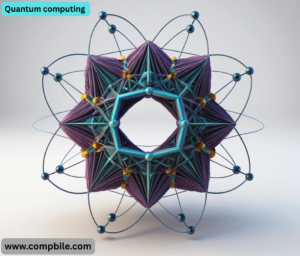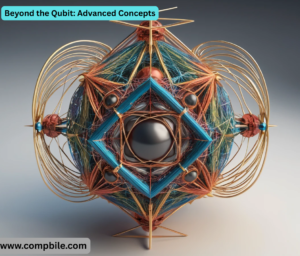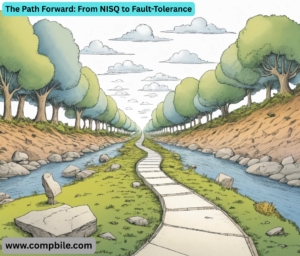Quantum computing Quantum computing is a rapidly evolving field that harnesses the principles of quantum mechanics to process information. Unlike classical computers, which use bits (0s and 1s), quantum computers use quantum bits or qubits. This fundamental difference allows them to solve certain types of problems that are intractable for even the most powerful classical supercomputers.
The Core Principle: The Qubit
- A qubit is like a dial with an arrow on a sphere (the Bloch sphere). Its key properties are:
- Superposition: A qubit can be in a state of 0 and 1 at the same time. It’s in a probabilistic blend of both states. When you measure it, it “collapses” to a definite 0 or 1.
- Analogy: Think of a spinning coin. While it’s spinning, it’s in a superposition of both heads and tails. Only when you stop it (measure it) does it become definitively one or the other.
- Measuring one entangled qubit tells you the state of its partner.
- Analogy: Imagine two magic dice. You roll them in different cities, but they always land on the same number. If one shows a 3, you instantly know the other shows a 3.
- These two properties are the superpowers of quantum computing. Superposition allows a quantum computer to explore a vast number of possibilities simultaneously. Entanglement allows qubits to be correlated in ways that enable complex, coordinated calculations.
How Does a Quantum Computer Work?
- Initialize: Set the qubits to a known starting state (e.g., all |0>).
- Manipulate (Quantum Gates): Apply a sequence of quantum logic gates. These gates manipulate the qubits, putting them into complex superpositions and entangling them with each other. This sequence of operations is a quantum algorithm.
- Measure: Finally, the qubits are measured. Due to superposition, the result is not a single answer but a probability distribution of possible outcomes. A
- Result: You run the entire process multiple times to get a statistical distribution of results, from which you can extract the answer.
Key Applications (The “Why”)
- Quantum computers are not faster for everyday tasks like browsing the web or running Word. They excel at specific, complex problems:
- Cryptography: Shor’s algorithm can break widely used encryption methods (like RSA) by efficiently factoring large numbers. This has sparked the parallel field of post-quantum cryptography to develop new, quantum-resistant algorithms.
- Drug Discovery & Materials Science: They can simulate molecular and atomic interactions with high accuracy. This could lead to the design of new medicines, fertilizers, and materials (e.g., better batteries or superconductors).
- Optimization: Problems like finding the most efficient route for logistics, optimizing financial portfolios, or improving supply chains could be solved much faster.
- Artificial Intelligence & Machine Learning: Accelerating certain ML tasks, like pattern recognition and classification, by quickly searching through vast feature spaces.
- Quantum Simulation: The original idea behind quantum computing—using a controllable quantum system to simulate other quantum systems that are too complex for classical computers (e.g., complex chemical reactions).
Major Challenges
Building a useful quantum computer is incredibly difficult.
- Decoherence: Qubits are extremely fragile. Any interaction with the external environment (heat, vibration, electromagnetic fields) causes them to lose their quantum properties (superposition and entanglement) in a process called decoherence. This introduces errors.
- Error Correction: Since qubits are so error-prone, a massive overhead of physical qubits is needed to create a single, stable “logical qubit” through quantum error correction. We likely need millions of high-quality physical qubits to run useful, error-corrected algorithms.
- Scalability: It’s a huge engineering challenge to build, control, and interconnect a large number of qubits while maintaining their coherence and low error rates.
Current State of the Field (As of 2023-2024)
- Noisy Intermediate-Scale Quantum (NISQ) Era: We are currently here. Companies like IBM, Google, IonQ, and Rigetti have built quantum processors with hundreds of qubits, but these qubits are noisy and prone to errors.
- Quantum Supremacy/Advantage: In 2019, Google’s Sycamore processor performed a specific, contrived calculation in 200 seconds that would take the world’s fastest supercomputer thousands of years to complete. This was a milestone to prove the principle, though the task itself had no practical use.
- The Goal: Fault-Tolerant Quantum Computing: The long-term goal is to build large-scale, fault-tolerant quantum computers with millions of error-corrected qubits that can run practical, useful algorithms. This is likely still decades away.
Key Players
- Startups: IonQ, Rigetti, Quantinuum, PsiQuantum
- Research Institutions: Universities and national labs worldwide are driving fundamental research.
Beyond the Qubit: Advanced Concepts
Quantum Volume (QV)
- Qubit count alone is a poor measure of a quantum computer’s power. A more holistic metric is Quantum Volume, which considers:
Number of qubits
- Connectivity (how qubits are linked)
- Gate fidelity (error rates of operations)
- Coherence time (how long qubits stay stable)
- Cross-talk (interference between qubits)
- A higher QV indicates a more powerful and less error-prone device
Different Qubit Modalities
- There isn’t just one way to build a qubit. Different approaches have unique trade-offs:
- Superconducting Loops (Used by Google, IBM): Tiny, supercooled circuits. Pros: Fast operations, scalable manufacturing. Cons: Very short coherence times, must be kept extremely cold (~10 millikelvin).
- Trapped Ions (Used by IonQ, Quantinuum): Individual atoms suspended in a vacuum by electromagnetic fields. Pros: Long coherence times, high-fidelity operations, strong qubit connectivity. Cons: Slower operation speeds, more complex scaling to many qubits.
- Photonic Qubits (Used by PsiQuantum, Xanadu): Use particles of light (photons). Pros: Can operate at room temperature, naturally resilient to decoherence. Cons: Challenging to get photons to interact for logic gates, requires complex hardware.
- Semiconductor Spin Qubits (Research focus for Intel, others): Similar to traditional transistors, using the spin of an electron. Pros: Potential for integration with classical silicon chip manufacturing. Cons: Still early in development, faces significant coherence and control challenges.
The Software Stack
Quantum computers require a full software ecosystem:
- High-Level Algorithms: Developers write code using quantum algorithms (e.g., Shor’s, Grover’s, VQE) in libraries like Qiskit (IBM), Cirq (Google), or PennyLane.
- Compilers: This code is compiled and optimized. The compiler decides how to best map the logical circuit onto the specific physical architecture of a quantum processor, minimizing errors and the number of operations.
- Pulse Control: The compiled instructions are converted into precise microwave or laser pulses that actually control the qubits.
- Classical Co-Processing: The output of a quantum computer is a set of probabilities. A classical computer is always needed to analyze these results, run error mitigation techniques, and feed information back into the next quantum computation. This is the basis of Hybrid Quantum-Classical algorithms.
Beyond Cryptanalysis: Deeper Dive on Applications
- Quantum Machine Learning (QML): Not just speedup. QML explores fundamentally different models.
- Quantum Neural Networks (QNNs): Use parameterized quantum circuits that can learn features in high-dimensional data spaces that are classically inaccessible.
- Quantum Kernels: Can compute similarity between data points in a high-dimensional “quantum feature space,” potentially offering exponential speedups for classification tasks.
Quantum Chemistry & Simulation:
- The “killer app.” Precisely modeling a molecule with N electrons requires tracking 2^N states—a number that grows exponentially and quickly becomes impossible for classical computers.
- A quantum computer can naturally represent this system with roughly N qubits. This could revolutionize the design of everything from new catalysts (for making fertilizer more efficient) to novel battery materials.
Financial Modeling:
- Quantum algorithms can provide a quadratic speedup (Grover’s algorithm), making these computationally intensive simulations much faster.
The Path Forward: From NISQ to Fault-Tolerance
The journey to practical quantum computing is a staged one:
- NISQ Era (Now): Use today’s noisy devices for:
- Education & Algorithm Development: Building the tools and skills for the future.
- Quantum Supremacy/Advantage Demonstrations: Proving quantum processors can do something classical ones can’t, even if it’s not useful.
- Limited Exploration: Running small-scale versions of chemistry or optimization problems and using advanced error mitigation techniques to extract useful signals from the noise.
The Era of Quantum Utility (Beginning Now):
- This is the emerging concept of using today’s NISQ processors to generate results that are usefully accurate and could provide a value beyond what is easily achievable classically, even if a supercomputer could eventually solve it.
- Example: In 2023, IBM and UC Berkeley used a 127-qubit processor to simulate a magnetic material and computed properties that aligned with real-world experiments, a task that would be extremely challenging for classical methods. This is a step towards utility.
Fault-Tolerant Quantum Computing (FTQC – The Future):
- This is the end goal. Using quantum error correction (QEC) codes (e.g., the surface code) to create stable “logical qubits” from many error-prone “physical qubits.”
- Estimates suggest it might take 1,000+ physical qubits to create a single, high-fidelity logical qubit. Therefore, we need machines with millions of physical qubits to run complex, useful algorithms. This is a long-term engineering goal.
Philosophical and Ethical Considerations
The field also raises profound questions:
- The Nature of Reality: Quantum computing is a practical engineering field testing the most bizarre predictions of quantum mechanics. Does it force us to reconsider interpretations of reality?
- Quantum computing is the most serious challenge to this thesis ever discovered.
- Access and Equity: If this technology is as powerful as predicted, who controls it? Could it create a “quantum divide” between nations, corporations, and people?




